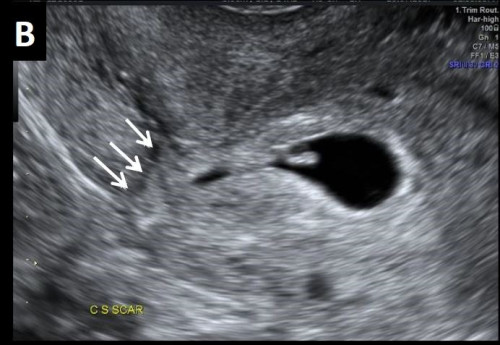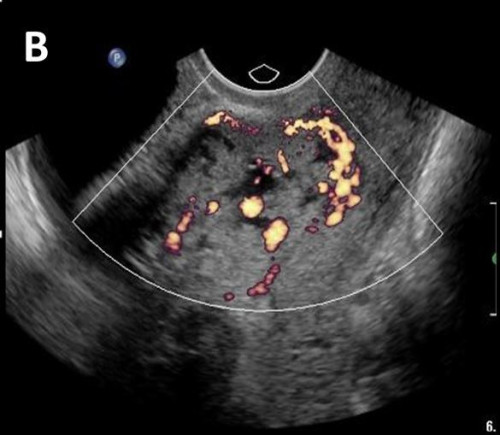The presence of a sac located in an abnormally low position within the uterus in the first trimester in a woman who has had one or more caesarean sections should prompt careful further review, including transvaginal (TV) scanning, if possible.
The differential diagnosis includes a normally developing but low sac that shows normal subsequent development on follow-up scans, an inevitable miscarriage (which appears avascular), scar ectopic or abnormally adherent trophoblast/placenta (early evidence of placenta accreta/abnormally implanted placenta).
Early placenta accreta / abnormally implanted trophoblast / placenta
The trophoblast is directly implanted over the scar. These cases may be very difficult to differentiate from scar ectopic pregnancies.
A TV ultrasound scan is recommended to assess location of the pregnancy. Implantation into the previous caesarean section scar can be diagnosed when:
- the gestational sac is low lying and located anteriorly or deviated towards the scar, within the lower uterus, at the level of the internal os
- there is increased peritrophoblastic or periplacental vascularity on colour Doppler examination and high-velocity (peak velocity >20 cm/s), low-impedance (pulsatility index <1) flow velocity waveforms on pulsed Doppler, in keeping with functional trophoblastic/placental circulation
- there is negative ‘sliding organs sign’, in the first trimester defined as the inability to displace the gestational sac from its position at the level of the internal os using gentle pressure applied by the TV probe.
The scar may be thin, or deficient, with a visible gap in the myometrium of the anterior uterine wall. The gestational sac may bulge towards the bladder in these cases.
From about 16 weeks, irregular vascular sinuses appear, with turbulent flow.
The bladder wall may appear interrupted or have small bulges of the placenta into the bladder space. Absence of the normal retroplacental ‘clear zone’ (the echolucent space between the placenta and myometrium) may be unreliable.
Colour Doppler may show placental bed hypervascularity and that some of the placental sinuses traverse the uterine wall.
Image A2.1




Low implantation of the gestational sac in a retroverted uterus (TV scan) (A), with the sac deviated anteriorly into the scar, arrows (B), suspicious for early accreta / abnormal trophoblast implantation.
Scans later in pregnancy showed complete placenta previa and accreta.
Caesarean scar ectopic pregnancy
The pregnancy is entirely contained within the myometrial confines of the scar, with no part within the cavity itself, unlike in first-trimester cases of abnormally implanted trophoblast/placenta accreta.
Image A2.2




Abnormal trophoblastic tissue implanted entirely within the confines of the caesarean section scar, separate from the endometrial cavity (arrows), in greyscale (A), and colour Doppler (B).